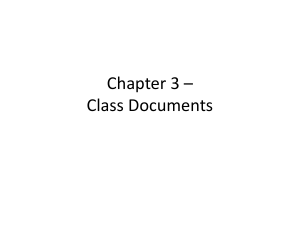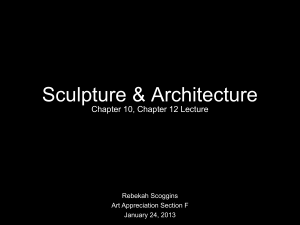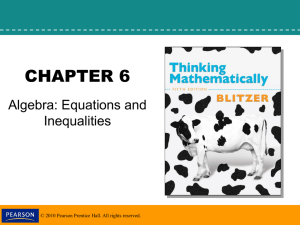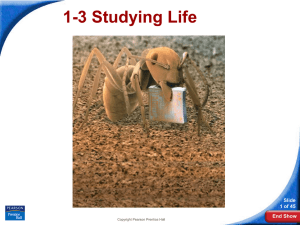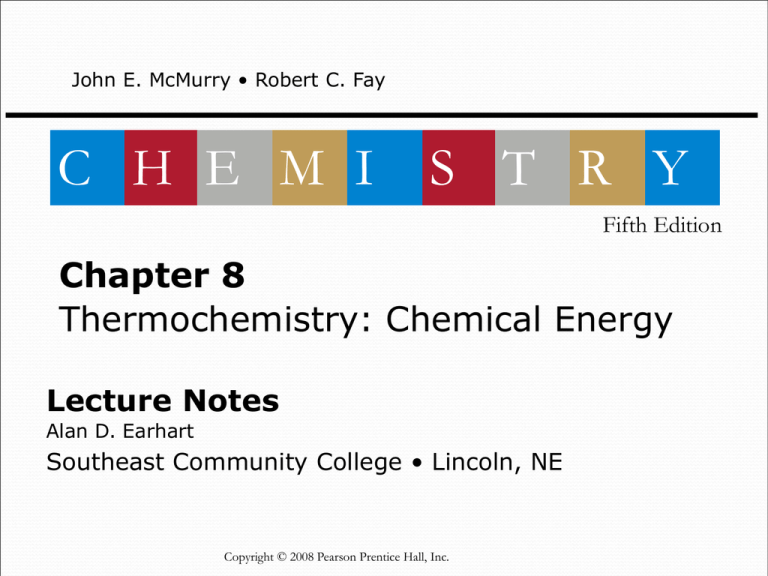
John E. McMurry • Robert C. Fay
C H E M I
S T R Y
Fifth Edition
Chapter 8
Thermochemistry: Chemical Energy
Lecture Notes
Alan D. Earhart
Southeast Community College • Lincoln, NE
Copyright © 2008 Pearson Prentice Hall, Inc.
8.1 Energy
Energy: The capacity to supply heat or do work.
Kinetic Energy (EK): The energy of motion.
Potential Energy (EP): Stored energy.
Units:
1 cal = 4.184 J (exactly)
1 Cal = 1000 cal = 1 kcal
Copyright © 2008 Pearson Prentice Hall, Inc.
Chapter 8/2
8.2 Energy Changes and Energy
Conservation
Law of Conservation of Energy: Energy cannot be created
or destroyed; it can only be converted from one form to
another.
Copyright © 2008 Pearson Prentice Hall, Inc.
Chapter 8/3
Energy Changes and Energy
Conservation
Total Energy = EK + EP
Copyright © 2008 Pearson Prentice Hall, Inc.
Chapter 8/4
Energy Changes and Energy
Conservation
Thermal Energy: The kinetic energy of molecular motion
and is measured by finding the temperature of an object.
Heat: The amount of thermal energy transferred from one
object to another as the result of a temperature difference between
the two.
Copyright © 2008 Pearson Prentice Hall, Inc.
Chapter 8/5
8.3 Internal Energy and State
Functions
First Law of Thermodynamics: The total internal energy of an isolated system is
constant.
DE = Efinal - Einitial
Copyright © 2008 Pearson Prentice Hall, Inc.
Chapter 8/6
Internal Energy and State
Functions
CH4(g) + 2O2(g)
CO2(g) + 2H2O(g) + 802 kJ energy
DE = Efinal - Einitial = -802 kJ
802 kJ is released when 1 mole of methane, CH4, reacts with 2
moles of oxygen to produce 1 mole of carbon dioxide and two
moles of water.
Copyright © 2008 Pearson Prentice Hall, Inc.
Chapter 8/7
Internal Energy and State
Functions
State Function: A function or property whose value depends
only on the present state, or condition, of the system, not on the
path used to arrive at that state.
Copyright © 2008 Pearson Prentice Hall, Inc.
Chapter 8/8
8.4 Expansion Work
Work = Force x Distance
w=Fxd
Copyright © 2008 Pearson Prentice Hall, Inc.
Chapter 8/9
Expansion Work
Expansion Work: Work done as the result of a volume change in the
system. Also called pressure-volume or PV work.
Copyright © 2008 Pearson Prentice Hall, Inc.
Chapter
8/10
8.5 Energy and Enthalpy
DE = q + w
q = heat transferred
w = work = -PDV
q = D E + PD V
Constant Volume (DV = 0):
Constant Pressure:
qV = DE
qP = DE + PDV
Copyright © 2008 Pearson Prentice Hall, Inc.
Chapter
8/11
Energy and Enthalpy
qP = DE + PDV = DH
Enthalpy change
or
Heat of reaction (at constant pressure)
Enthalpy is a state function whose value depends
only on the current state of the system, not on the
path taken to arrive at that state.
Copyright © 2008 Pearson Prentice Hall, Inc.
DH = Hfinal - Hinitial
= Hproducts - Hreactants
Chapter
8/12
8.6The Thermodynamic
Standard State
C3H8(g) + 5O2(g)
3CO2(g) + 4H2O(g)
DH= -2043 kJ
C3H8(g) + 5O2(g)
3CO2(g) + 4H2O(l)
DH = -2219 kJ
Thermodynamic Standard State: Most stable form of a substance at 1 atm pressure
and at a specified temperature, usually 25 °C; 1 M concentration for all substances in
solution.
Standard enthalpy of reaction is indicated by the symbol ΔHo
C3H8(g) + 5O2(g)
3CO2(g) + 4H2O(g)
Copyright © 2008 Pearson Prentice Hall, Inc.
DH° = -2043 kJ
Chapter
8/13
8.7 Enthalpies of Physical and
Chemical Change
Enthalpy of Fusion (DHfusion): The amount of heat necessary to melt a
substance without changing its temperature.
Enthalpy of Vaporization (DHvap): The amount of heat required to
vaporize a substance without changing its temperature.
Enthalpy of Sublimation (DHsubl): The amount of heat required to convert
a substance from a solid to a gas without going through a liquid phase.
Copyright © 2008 Pearson Prentice Hall, Inc.
Chapter
8/14
Enthalpies of Physical and
Chemical Change
Copyright © 2008 Pearson Prentice Hall, Inc.
Chapter
8/15
Enthalpies of Physical and
Chemical Change
2Al(s) + Fe2O3(s)
2Fe(s) + Al2O3(s)
DH° = -852 kJ
exothermic
2Fe(s) + Al2O3(s)
2Al(s) + Fe2O3(s)
DH° = +852 kJ
endothermic
Copyright © 2008 Pearson Prentice Hall, Inc.
Chapter
8/16
Examples
Identify each of the following processes as endothermic or
exothermic and indicate the sign of ΔHo
Sweat evaporating from your skin
Water freezing in a freezer
Wood burning in fire
Example
An LP gas tank in a home barbeque contains 13.2 kg of
propane, C3H8. Calculate the heat (in kJ) associated with the
complete combustion of all of the propane in the tank
C3H8(g) + 5O2(g) 3 CO2(g) + 4 H2O(g)
ΔHo = -2044kJ
Example
How much heat (in kJ) is evolved when 5.00g of aluminum
reacts with a stoichiometric amount of Fe2O3?
2 Al(s) + Fe2O3(s) 2 Fe(s) + Al2O3(s) ΔHo = -852 kJ
8.8Calorimetry and Heat Capacity
A temperature change is
observed when a system gains or
loses energy in the form of heat
(ΔH)
Amount of heat gained =
amount of heat lost
qcal = -qrxn
qgain = -qlost
Copyright © 2008 Pearson Prentice Hall, Inc.
Chapter
8/20
Calorimetry and Heat Capacity
Measure the heat flow at constant volume (DE).
Copyright © 2008 Pearson Prentice Hall, Inc.
Chapter
8/21
Calorimetry and Heat Capacity
Heat Capacity (C): The amount of heat required to raise the temperature of an
object or substance a given amount.
q = C m x DT
Molar Heat Capacity (Cm): The amount of heat required to raise the temperature
of 1 mol of a substance by 1 °C.
q = (Cm) x (moles of substance) x DT
Specific Heat: The amount of heat required to raise the temperature of 1 g of a
substance by 1 °C.
q = (specific heat) x (mass of substance) x DT
Copyright © 2008 Pearson Prentice Hall, Inc.
Chapter
8/22
Calorimetry and Heat Capacity
Copyright © 2008 Pearson Prentice Hall, Inc.
Chapter
8/23
Examples
Assuming that Coca Cola has the same specific heat as water
[4.183 J/goC], calculate the amount of heat (in kJ)
transferred when one can (about 350.0 g) is cooled from
25.0oC – 3.0oC
Example
When 25.0 mL of 1.0 M H2SO4 is added to 50.0ml of 1.0 M
NaOH at 25.0oC in a calorimeter, the temperature of the
aqueous solution increases to 33.9oC. Assuming that the
specific heat of the solution is 4.18 J/g oC, that its density is
1.00g/mL, and the calorimeter itself absorbs a negligible
amount of heat, calculate ΔH (in kJ/mol) for the reaction
H2SO4(aq) + 2 NaOH(aq) 2 H2O(l) + Na2SO4(aq)
8.9 Hess’s Law
Hess’s Law: The overall enthalpy change for a reaction is equal to the sum of the
enthalpy changes for the individual steps in the reaction.
Haber Process:
3H2(g) + N2(g)
2NH3(g)
DH° = -92.2 kJ
Multiple-Step Process - Given
2H2(g) + N2(g)
N2H4(g)
N2H4(g) + H2(g)
2NH3(g)
3H2(g) + N2(g)
2NH3(g)
Copyright © 2008 Pearson Prentice Hall, Inc.
DH°1 = ?
DH°2 = -187.6 kJ
DH°1+2 = -92.2 kJ
Chapter
8/26
Hess’s Law
Copyright © 2008 Pearson Prentice Hall, Inc.
Chapter
8/27
Example
Find ΔHorxn for the following reaction:
3H2(g) + O3(g) 3 H2O(g)
ΔHorxn = ??
Use the following reactions with known ΔH’s
2H2 (g) + O2(g) 2 H2O(g)
Δ Ho = -483.6 kJ
3O2(g) 2 O3 (g)
Δ Ho = +285.4 kJ
Typo from original note
Example
Fin ΔHorxn for the following reaction
C(s) + H2O(g) CO(g) + H2(g)
Horxn = ?
Use the following reactions with known H’s
C(s) + O2(g) CO2(g)
ΔHo = -393.5 kJ
2CO(g) + O2(g) 2CO2(g)
Δ Ho = -566.0kJ
2H2 (g) + O2(g) 2H2O (g)
Δ Ho = -483.6 kJ
8.10 Standard Heats of Formation
Standard Heat of Formation (DH°f ): The enthalpy change for the formation of 1
mol of a substance in its standard state from its constituent elements in their standard
states.
Standard states
C(s) + 2H2(g)
CH4(g)
DH°f = -74.8 kJ
1 mol of 1 substance
Copyright © 2008 Pearson Prentice Hall, Inc.
Chapter
8/30
Standard Heats of Formation
Copyright © 2008 Pearson Prentice Hall, Inc.
Chapter
8/31
Standard Heats of Formation
DH° = DH°f (Products) - DH°f (Reactants)
aA + bB
cC + dD
DH° = [c DH°f (C) + d DH°f (D)] - [a DH°f (A) + b DH°f (B)]
Products
Reactants
Copyright © 2008 Pearson Prentice Hall, Inc.
Chapter
8/32
Standard Heats of Formation
Using standard heats of formation, calculate the standard enthalpy of
reaction for the photosynthesis of glucose (C6H12O6) and O2 from CO2 and
liquid H2O.
6CO2(g) + 6H2O(l)
C6H12O6(s) + 6O2(g)
Copyright © 2008 Pearson Prentice Hall, Inc.
DH° = ?
Chapter
8/33
Example
Use the information in Table 8.2 to calculate ΔHo (in kJ) for
the reaction of ammonia with oxygen gas to yield nitric
oxide (NO) and water vapor, a step in the Ostwald process
for the commercial production of nitric acid
8.11 Bond Dissociation Energies
Bond dissociation energies are standard enthalpy changes for
the corresponding bond-breaking reactions.
Copyright © 2008 Pearson Prentice Hall, Inc.
Chapter
8/35
Bond Dissociation Energies
H2(g) + Cl2(g)
2HCl(g)
DH° = D(Reactant bonds) - D(Product bonds)
DH° = (DH-H + DCl-Cl) - (2DH-Cl)
Copyright © 2008 Pearson Prentice Hall, Inc.
Chapter
8/36
8.12 Fossil Fuels, Fuel Efficiency,
and Heats of Combustion
CH4(g) + 2O2(g)
CO2(g) + 2H2O(l)
Copyright © 2008 Pearson Prentice Hall, Inc.
Chapter
8/37
Fossil Fuels, Fuel Efficiency,
and Heats of Combustion
H2(g) + ½ O2(g) H2O(l)
CH4(g) + 2O2(g)
ΔHoc = -285 kJ/mol
CO2(g) + 2H2O(l)
Copyright © 2008 Pearson Prentice Hall, Inc.
ΔHoc = -890.3 kJ/mol
Chapter
8/38
8.13 An Introduction to Entropy
Spontaneous Process: A process that, once started, proceeds on its
own without a continuous external influence.
Entropy (S): The amount of molecular randomness in a system.
Spontaneous processes are
•
•
favored by a decrease in H (negative DH).
favored by an increase in S (positive DS).
Nonspontaneous processes are
•
•
favored by an increase in H (positive DH).
favored by a decrease in S (negative DS).
Copyright © 2008 Pearson Prentice Hall, Inc.
Chapter
8/39
An Introduction to Entropy
Example
Predict whether ΔSo is likely to be positive or negative for
each of the following reactions
H2C=CH2(g) + Br2(g) BrCH2CH2Br(l)
8.14 An Introduction to Free Energy
Gibbs Free Energy Change (DG)
DG = DH - T DS
Enthalpy of
reaction
Temperature
(Kelvin)
Copyright © 2008 Pearson Prentice Hall, Inc.
Entropy
change
Chapter
8/42
An Introduction to Free Energy
Gibbs Free Energy Change (DG)
DG =
DH - T DS
DG < 0
Process is spontaneous
DG = 0
Process is at equilibrium
(neither spontaneous nor nonspontaneous)
DG > 0
Process is nonspontaneous
Copyright © 2008 Pearson Prentice Hall, Inc.
Chapter
8/43
Example
Is the Haber process for the industrial synthesis of
ammonia spontaneous or nonspontaneous under standard
conditions at 25.0oC. At what temperature (oC) does the
changeover occur?

